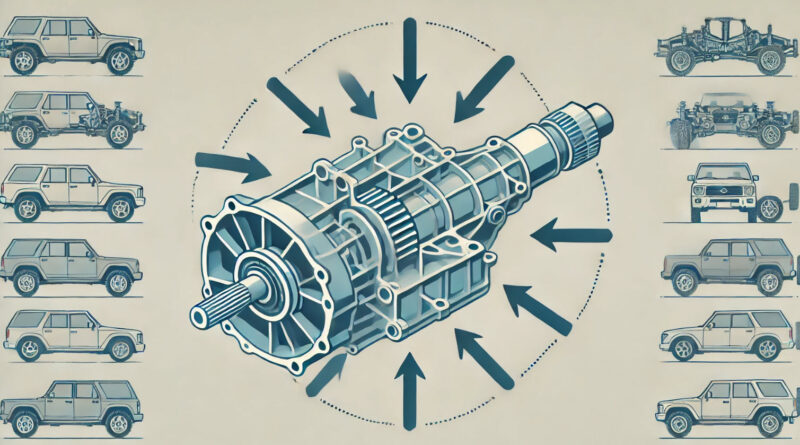What Is a Transfer Case, Why Does Car Need One?
If you drive an all-wheel drive (AWD) or four-wheel drive (4WD) vehicle, you’ve got a hardworking component behind the scenes making sure everything runs smoothly: the transfer case. You might not think about it often, but this little hero is the key to keeping all four wheels turning when you need extra grip, whether you’re tackling icy roads, muddy trails, or steep climbs.
Let’s break down what a transfer case is, how it works, and why it’s such a vital part of your vehicle.
So, What Exactly Is It?
The transfer box is a device in your car’s drivetrain that distributes power from the engine to both the front and rear axles. In simpler terms, it makes sure all four wheels work together when your car needs better traction or extra stability.
For AWD vehicles, the transfer box operates automatically, adjusting power based on road conditions. In 4WD vehicles, it’s what allows you to switch between 2WD and 4WD modes, giving you more control in tricky situations.
How Does a Transfer Case Work?
Here’s the basic idea:
- Gets Power from the Engine: takes power from the transmission and splits it between the front and rear axles.
- Distributes Torque: Depending on the system, it either sends equal power to both axles or adjusts it dynamically for better traction.
- Adapts to Conditions: lets you choose between high-range (normal driving) and low-range (tough terrain) settings.
In AWD vehicles, the transfer case works behind the scenes, so you don’t even have to think about it—it’s always working to keep your car stable.
Types of Transfer Cases
Not all are the same. Here are the most common ones you’ll find:
1. Part-Time Transfer Case
- Lets you manually switch between 2WD and 4WD.
- Ideal for off-road adventures but not meant for full-time use on paved roads.
2. Full-Time Transfer Case
- Always sends power to all four wheels, making it perfect for AWD vehicles.
- Great for handling mixed road conditions without requiring input from the driver.
3. Active or Intelligent Transfer Case
- Uses sensors and electronics to automatically adjust torque distribution in real time.
- Common in modern AWD vehicles, offering smooth and seamless performance.
Why Is It Important?
Plays a critical role in your vehicle’s performance. Here’s why it’s so important:
1. Better Traction
By sending power to all four wheels, the transfer case keeps your car stable on slippery or uneven surfaces like snow, mud, or gravel.
2. Off-Road Capability
For 4WD vehicles, the transfer case lets you engage low-range gears, giving you the extra torque needed to tackle steep climbs or tough trails.
3. Balanced Power
In AWD systems, the transfer case helps maintain stability by distributing power where it’s needed most, whether you’re cornering or accelerating.
4. Adaptability
Whether you’re navigating rough terrain or just driving in bad weather, the transfer case helps your car handle it all with ease.
Signs Your Transfer Case Might Be in Trouble
A faulty transfer case can mess with your car’s performance. Here are some common warning signs to watch out for:
- Strange Noises: Grinding, whining, or clunking sounds while driving or shifting could mean worn gears or bearings.
- Trouble Shifting Modes: If you can’t switch between 2WD and 4WD, the transfer case might be the problem.
- Fluid Leaks: relies on special fluid for lubrication, so any leaks need immediate attention.
- Vibrations: Unusual vibrations, especially when accelerating, can be a sign of transfer case issues.
- 4WD Not Engaging: If your 4WD system isn’t working, the transfer case could be at fault.
If you notice any of these issues, it’s best to get your car checked out by a mechanic.
How to Keep It In Good Shape
With a little regular maintenance, your transfer case can last for years without any trouble. Here’s what you can do:
- Change the Fluid: Like engine oil, the transfer case fluid needs to be replaced periodically to keep everything running smoothly. Check your owner’s manual for recommended intervals.
- Check for Leaks: Keep an eye out for fluid leaks under your car.
- Use 4WD Regularly: If you have a part-time 4WD system, engage it occasionally to keep the components working properly.
- Service Promptly: If you hear strange noises or notice performance issues, don’t wait—get it looked at right away.
Transfer Case vs. Differential: What’s the Difference?
It’s easy to confuse the transfer box with the differential, but they serve different purposes:
- Transfer Case: Sends power from the engine to the front and rear axles.
- Differential: Allows the wheels on the same axle to rotate at different speeds, especially useful when turning.
Together, they work to give your car stability, traction, and control.
Who Benefits Most from a Transfer Box?
If you drive an AWD or 4WD vehicle, the transfer case is a game-changer. It’s especially valuable for:
- Off-Road Enthusiasts: Essential for climbing steep hills, crossing rivers, or navigating rough trails.
- Snow and Ice Drivers: Keeps your car stable and safe during winter commutes.
- Adventure Seekers: Perfect for tackling unpredictable terrain on weekend getaways.
Final Thoughts
The transfer case might not be the flashiest part of your car, but it’s one of the most important for vehicles with AWD or 4WD systems. It works behind the scenes to keep your wheels turning, your car stable, and your ride safe, no matter the terrain or weather conditions.
By taking care of your transfer case and keeping an eye out for warning signs, you’ll ensure your vehicle is ready to handle whatever the road—or trail—throws at you. So, the next time you’re cruising through rough terrain or navigating icy roads, you’ll know exactly what part of your car is making it all possible.
Buying a used VW. Buying used vauxhall, BMW, Jaguar, Ford, Volvo, Range rover, Bentley, Aston Martin, Porsche, Ferrari, Lamborghini, Maserati, Hyundai, Tesla, Honda, Pagani

